
The longhorn beetles (Cerambycidae), also known as long-horned or longicorns, are a large family of beetles, with over 35,000 species described.

Moneilema, or cactus longhorn beetles are a genus of large, flightless, black beetles found in North American deserts of the western United States and northern Mexico. M. gigas is native to the Sonoran Desert at elevations below 4900 feet (1500m). The front wings of these beetles are fused forming a single, hardened shell, from which the genus derives its Latin name. The genus includes twenty species.

Moneilema gigas is a large, flightless, black beetle native to the Sonoran desert at elevations below 1500 metres. The front wings are fused forming a single, hardened shell. Collectively - with 19 other Moneilema species - M. gigas is also known as the cactus longhorn beetle.
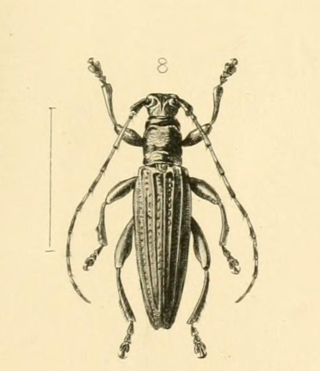
Xylotoles is a genus of beetle in the family Cerambycidae. It contains several species, including Xylotoles costatus, once thought extinct. The longhorn beetles belonging to genus Xylotoles is classified as Endangered (EN) on the IUCN Red List.

Heliocopris is a genus of Scarabaeidae or scarab beetles in the superfamily Scarabaeoidea. Forty-seven of the fifty-two known species are found in Africa, but a few are found in southern and southeast Asia.

Rutpela maculata, the spotted longhorn, is a beetle species of flower longhorns of the family Cerambycidae, subfamily Lepturinae.

Collyris is a genus in the beetle family Cicindelidae. There are about 10 described species in Collyris.

Agapanthia is a genus of flat-faced longhorn beetle belonging to the family Cerambycidae, subfamily Lamiinae.
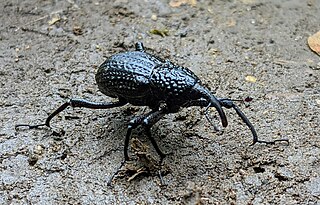
Sipalinus gigas is a species of beetles belonging to the family Curculionidae.
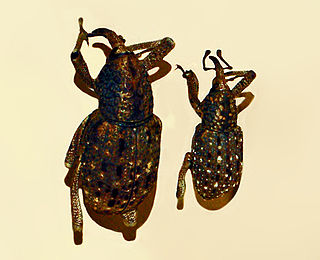
Sipalinus is a genus of beetles belonging to the family Curculionidae.

Acanthocinus is a genus of longhorn beetles of the subfamily Lamiinae. It was described by Megerle in 1821.

Acanthocinus griseus is a species of longhorn beetle of the subfamily Lamiinae. It was described by Johan Christian Fabricius in 1792 and is known from Europe, Russia, and Asia Minor. The beetles are 8-13 millimetres long and live for approximately 1–2 years. They inhabit coniferous trees including those in the genera Pinus, Picea, and Abies. They are also known to inhabit oaks.

Tetropium fuscum, the brown spruce longhorn beetle, is a species of beetle in the family Cerambycidae. It was described by Johan Christian Fabricius in 1787. Tetropium fuscum is native to Europe and Northern Asia, and has been introduced to Nova Scotia, Canada. Brown spruce longhorn is a pest of spruce trees.

Phryneta is a genus of flat-faced longhorn beetles belonging to the family Cerambycidae.
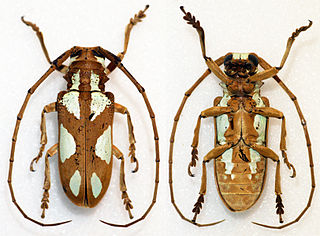
Prosopocera lactator, the Turquoise Longhorn, is a species of flat-faced longhorn beetles in the subfamily Lamiinae.
Cloniocerini is a tribe of longhorn beetles of the subfamily Lamiinae. It was described by Lacordaire in 1872. It contains the single genus Cloniocerus, and the following species:
Nyctimeniini is a tribe of longhorn beetles of the subfamily Lamiinae. It was described by Gressitt in 1951. It contains the single genus Nyctimenius.

Rhytiphora is a genus of flat-faced longhorn beetles in the Pteropliini tribe of the subfamily Lamiinae. The genus was first described in 1835 by Jean Guillaume Audinet-Serville.
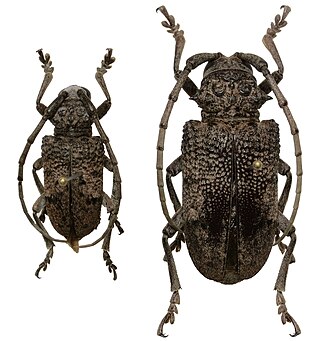
Phryneta spinator, the fig-tree borer longhorn beetle or fig tree borer, is a species of beetle in the family Cerambycidae. It was described by Johan Christian Fabricius in 1792, originally under the genus Lamia. It has a wide distribution throughout Africa. It feeds on Pyrus communis, Ficus carica, Salix babylonica, Cupressus sempervirens, and Vitis vinifera.
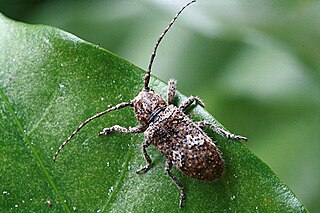
Rhytiphora bankii is a species of beetle in the family Cerambycidae. It was first described by Johan Christian Fabricius in 1775, under the genus Lamia. It is known from Australia, the Philippines, Borneo, Java, Micronesia, New Guinea, Hawaii, Moluccas, Sumatra, Vietnam, and has been introduced into Japan. The Australian species of Prosoplus were synonymised with Rhytiphora in 2013.

















